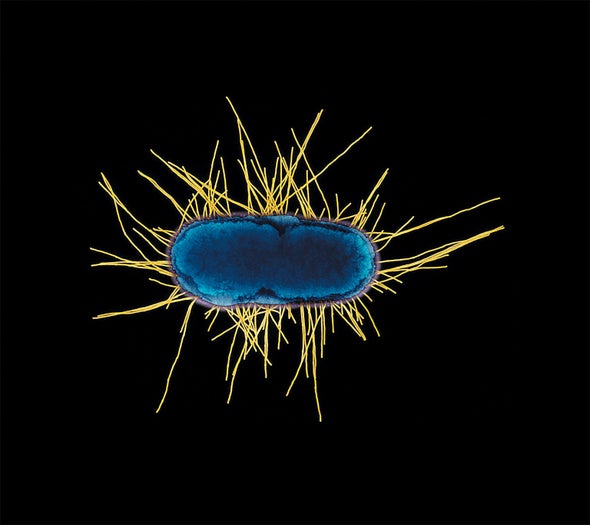DNA has a knotty problem. Thousands of times longer than the cell that contains it, this intricate strand of As, Ts, Gs and Cs must fold itself into a compact package. But the thin double helix molecule can’t jam itself in any which way, lest it wind up horribly knotted. What’s more, the cell needs certain segments of the strand—particular genes—to remain accessible to protein-making machinery while keeping others tucked away and turned off. It’s like playing Tetris with a tangled ball of yarn.
Nucleus-containing “eukaryotic” cells, the type found in humans, plants and animals, rely on complex interactions between chemical tags and specialized proteins to provide instructions about what genes to turn on and when—a system called epigenetics. For decades scientists thought epigenetic regulation was unique to eukaryotic cells and lacking in simpler ones, such as bacteria. But a series of newer findings has challenged that idea.
“Bacteria are way more sophisticated than anyone realized,” says David Low, a microbiologist at the University of California, Santa Barbara.
New studies by University of Michigan biochemists Ursula Jakob and Peter Freddolino reveal that interactions between DNA-binding proteins and an ancient molecule called polyphosphate help to switch bacteria’s genes on and off on a broad scale. Not only do these findings tell scientists more about such organisms’ basic biology, but they could also help researchers fine-tune genetically engineered bacteria for biotechnology—and even contribute to new antibiotics.
“Bacteria are carrying around the seeds of their own destruction, and we might be able to remove the repression that’s keeping [those seeds] down,” Freddolino says.
Eukaryotic cells have long been known to use multiple layers of regulation, controlling which genes are active and how much of a given protein each one makes. Bacterial DNA, on the other hand, was typically portrayed in textbooks as a long piece of inert string, waiting to be transcribed. That idea began to unravel in 1994, when Low discovered that a chemical tag called a methyl group could block transcription in bacteria—something scientists had thought was exclusive to eukaryotic cells.
More similarities have emerged over the years. For example, eukaryotic cells attach chemical tags and proteins called histones to hide away parts of the genome. Last year Freddolino’s laboratory showed that bacteria use an analogous strategy: the researchers identified 200 regions in the Escherichia coli genome that are silenced using chemical tags and structures called nucleoid-associated proteins (NAPs).
For a recent study in the EMBO Journal, Freddolino demonstrated that NAPs worked similarly to silence specific sections of the bacterial genome in distantly related species E. coli and Bacillus subtilis. The NAP acts as a scaffold around which a portion of DNA gets wrapped, making it physically impossible for the cell’s protein-making machinery to access genes in that portion. This effect is critically important for bacteria: it allows them to seal off snippets of outside DNA and viruses that have wedged their way into the bacterial genome, and it lets them wall off rarely used genes when they are not needed.
NAPs do not work alone, however. To determine what triggers them to switch off sections of DNA, Freddolino and Jakob turned their attention to polyphosphate. This molecule was used for energy storage by Earth’s early life and has evolved a variety of functions in cells. In 2020 Jakob found that mutant E. coli unable to synthesize polyphosphate showed more activity in genes absorbed from outside the cell—and that this activity plays a key role in cell death from DNA damage.
Recently, in Science Advances, Jakob and Freddolino showed that negatively charged polyphosphate binds to positively charged NAPs using a process called liquid-liquid phase separation, in which ultradense protein groups condense into tiny droplets. As more and more polyphosphate attaches to the NAPs, the normally scattershot structure of polyphosphate, NAPs and DNA becomes organized. Just as oil droplets can form in even a well-mixed vinaigrette, droplets of protein, DNA and polyphosphate can congeal in bacterial cells—and this blocks parts of the genome from transcription. The process does not need additional helper proteins, and it can be reversed when polyphosphate levels drop.
These studies are a major step in understanding bacterial epigenetics, says University of Leiden biochemist Remus Dame, who was not involved in either study. “There’s good reason to believe that the global structure in which these genes are embedded dictates how active they are,” he says. “This is really something very new—and very hot—that means we have to look differently at our system of interest.”
Freddolino says that when his biotechnology-focused colleagues first learned of these results, they began using this knowledge to insert engineered genes into spots along the bacterial genome that optimize protein production. The process, he says, has since gone from “cross your fingers and hope for the best” to a sound strategy that works almost every time.
At the Massachusetts Institute of Technology, biochemist Peter Dedon is investigating how scientists can make new antibiotics using these mechanisms. Work from his lab (and others around the world) shows that bacteria switch genes on and off to help infect hosts—and to resist antibiotics. Dedon envisions a small molecule that could interfere with this process and keep a bacterium’s infection-boosting characteristics or antibiotic resistance genes switched off; another option would be to disrupt polyphosphate’s ability to bind to NAPs. This would not kill bacteria outright, but it would render them less able to cause disease and more susceptible to immune system attacks. “There’s great potential there,” Dedon says. “There’s a whole new world of antibiotic targets.”
Bacterial epigenetics is an excellent focus for antibiotic development, Jakob says, because its mechanisms are shared across many bacteria species—but use fundamentally different proteins than eukaryotic cells do. This means researchers can specifically target bacterial proteins and avoid interfering with the body’s own epigenetic processes, Jakob says: “It’s a way to prevent disease without needing to kill the cell.”


